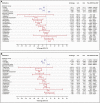Do Inpatient Antimicrobial Stewardship Programs Help Us in the Battle Against Antimicrobial Resistance?
- PMID: 32667983
- PMCID: PMC8673436
- DOI: 10.1093/cid/ciaa1004
Do Inpatient Antimicrobial Stewardship Programs Help Us in the Battle Against Antimicrobial Resistance?
Abstract
Background: Antibiotic stewardship programs (ASPs) have demonstrated success at reducing costs, yet there is limited quality evidence of their effectiveness in reducing infections of high-profile drug-resistant organisms.
Methods: This retrospective, cohort study included all Kaiser Permanente Southern California (KPSC) members aged ≥18 years hospitalized in 9 KPSC hospitals from 1 January 2008 to 31 December 2016. We measured the impact of staggered ASP implementation on consumption of 18 ASP-targeted antibiotics using generalized linear mixed-effects models. We used multivariable generalized linear mixed-effects models to estimate the adjusted effect of an ASP on rates of infection with drug-resistant organisms. Analyses were adjusted for confounding by time, cluster effects, and patient- and hospital-level characteristics.
Results: We included 765 111 hospitalizations (288 257 pre-ASP, 476 854 post-ASP). By defined daily dose, we found a 6.1% (-7.5% to -4.7%) overall decrease antibiotic use post-ASP; by days of therapy, we detected a 4.3% (-5.4% to -3.1%) decrease in overall use of antibiotics. The number of prescriptions increased post-ASP (1.04 [1.03-1.05]). In adjusted analyses, we detected an overall increase in vancomycin-resistant enterococci infections post-ASP (1.37 [1.10-1.69]). We did not detect a change in the rates of extended-spectrum beta-lactamase, carbapenem-resistant Enterobacteriaceae, and multidrug-resistant Pseudomonas aeruginosa infections post-ASP.
Conclusions: ASPs with successful reductions in consumption of targeted antibiotics may not see changes in infection rates with antibiotic-resistant organisms in the 2 to 6 years post-implementation. There are likely differing timescales for reversion to susceptibility across organisms and antibiotics, and unintended consequences from compensatory prescribing may occur.
Keywords: antibiotic consumption; antibiotic resistance; antibiotic stewardship.
© The Author(s) 2020. Published by Oxford University Press for the Infectious Diseases Society of America. All rights reserved. For permissions, e-mail: journals.permissions@oup.com.
Figures


References
-
- Centers for Disease Control and Prevention. Antibiotic resistance threats in the United States, 2019.2019. Available at: https://www.cdc.gov/drugresistance/pdf/threats-report/2019-ar-threats-re.... Accessed 5 February 2020.
-
- Infectious Diseases Society of America. Antimicrobial Resistance: A Public Health Crisis. https://www.idsociety.org/globalassets/idsa/topics-of-interest/antimicro.... Accessed 8 October 2020.
-
- Dellit TH, Owens RC, McGowan JE Jr, et al. ; Infectious Diseases Society of America; Society for Healthcare Epidemiology of America . Infectious Diseases Society of America and the Society for Healthcare Epidemiology of America guidelines for developing an institutional program to enhance antimicrobial stewardship. Clin Infect Dis 2007; 44:159–77. - PubMed

